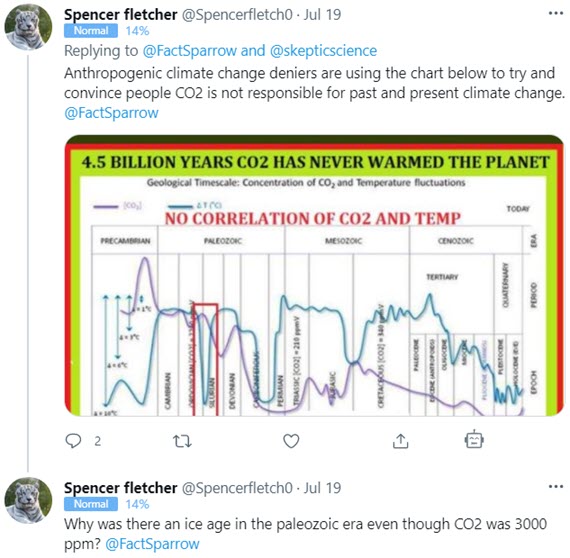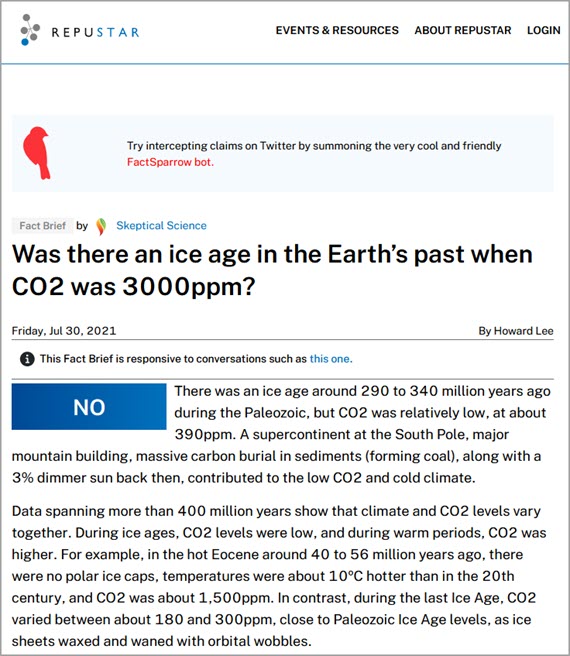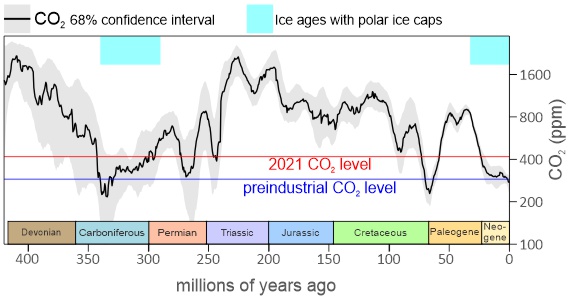From tweet to updated rebuttal - a little saga
Posted on 3 September 2021 by BaerbelW
This blog post tells the little saga of how a tweet aimed at Repustar's @Fact Sparrow led to a quickly drafted new Fact Brief and how our internal review of the brief made it clear in turn that our related rebuttals were in dire need of updates as well.
The Tweet
On July 19, Spencer Fletcher tweeted the question "Why was there an ice age in the paleozoic era even though CO2 was 3000 ppm?" at @Fact Sparrow, Repustar's friendly fact delivery bot:
FactSparrow logged Fletcher's concern about this topic and promised to keep looking for more information. Acting on this promise included a notifcation from Repustar's staff to our team, to see if we - as one of Repustar's content partners - could help out with a new Fact Brief to answer Spencer's question.
Drafting and reviewing the Fact Brief
As I had some time available, I quickly drafted a Fact Brief edited down to 140 words from our related rebuttal's basic version. That rebuttal version had placed a lot of emphasis on the fact that the sun was less bright in Earth's early history. But Earth has been around for 4.6 billion years, and the sun has only brightened by about 3% since the Paleozoic, so we needed to check it with team members who know about climates of the past, namely Peter Jacobs and Howard Lee. Both were quick to respond.
Peter referred me to a paper by Foster et al. 2017 showing CO2 levels for the last 420 million years, in the context of a 4% increase in solar luminosity since then.
"When CO2 was higher in the past climate was warmer, when it was lower in the past it was cold," Howard said in an email. "The solar luminosity thing is a red herring, especially since the weathering feedback has compensated for it (Foster et al. 2017) and the difference in luminosity is small over that time period. The Paleozoic ice age, for example, had CO2 levels not far off those of the last 3 million years. The rebuttal’s figures based on Geocarbsulf are horribly out of date now. The Lavoisier denial is a mishmash of wrong facts and wrong inferences. There wasn’t glaciation at times of high CO2. There isn’t runaway greenhouse because of the weathering feedback. The Ordovician is pushing the limits of climate proxies but I recall there have been newer, improved proxy data even for back then."
Howard offered to revise both the Fact Brief and the rebuttals to bring them up-to-date with current information. As this would take some time, I added a note at the top of the rebuttals to make readers aware that updates were being worked on:
"Please note: Records of past CO2 and temperature have improved considerably since this rebuttal was written, reconfirming CO2 is the principal ‘control knob’ on climate. This rebuttal is currently being revised and an updated version will be published as soon as it becomes available."
Updating the draft and publishing the Fact Brief
Howard quickly re-created the draft for the Fact Brief which then also had a reworded question and a "NO" as the answer - so, quite a u-turn from what we started out with!
Was there an ice age in the Earth’s past when CO2 was 3000ppm?
NO
There was an ice age around 340-290 million years ago during the Paleozoic, but CO2 was relatively low, at about 390ppm. A supercontinent at the South Pole, major mountain building, massive carbon burial in sediments (forming coal), along with a 3% dimmer sun back then, contributed to the low CO2 and cold climate.
Data spanning more than 400 million years show that climate and CO2 levels have varied together. During ice ages CO2 levels were low, and during warm periods CO2 was higher. In the hot Eocene, for example, there were no polar ice caps, temperatures were about 10ºC hotter than the 20th Century, and CO2 was about 1,500ppm. In contrast, during the last Ice Age, CO2 varied between about 180 and 300ppm, close to Paleozoic Ice Age levels, as ice sheets waxed and waned with orbital wobbles.
I updated the draft in the Repustar editing system and also added the references Howard had included in the Fact Brief:
- Earth and Planetary Science Letters Late Paleozoic Ice Age glaciers shaped East Antarctica landscape
- Nature Climate, p CO2 and terrestrial carbon cycle linkages during late Palaeozoic glacial–interglacial cycles
- Annual Reviews Extra An Atlas of Phanerozoic Paleogeographic Maps: Plate Tectonics Pgeog & Ice
- Nature Future climate forcing potentially without precedent in the last 420 million years
- Science An astronomically dated record of Earth’s climate and its predictability over the last 66 million years
- Annual Reviews Atmospheric CO2 over the Past 66 Million Years from Marine Archives
- Palaeo-CO2 CO2 in the geological past
John Cook submitted the Fact Brief and Repustar published it on July 30, making this our fastest published brief to date with about 10 days from initial draft to publication!
Updating the rebuttals
With the Fact Brief "out of the way", Howard started to work on the rebuttals with the basic version as the first one to get updated. For this relatively short rebuttal version, Howard put the focus on the CO2 concentrations of the past 420 million years and explained how Earth’s long-term climate (over millions of years) is governed by the balance between CO2 emitted into the atmosphere by volcanoes and CO2 removed from the atmosphere by weathering of rocks (Joel 2017).
Afterwards, Howard set out to work on the much longer and complex intermediate rebuttal version which expands on the basic version, and gets to grips with "Snowball Earth" scenarios where climate was temporarily cold when CO2 was temporarily high. It also includes a list of non-CO2 drivers of the climate system. Not only did Howard write this rebuttal version he also added about 50 references to our ever expanding glossary while doing so!
CO2 levels for the last 420 million years, showing periods with ice ages. Note this curve is smoothed and too low resolution to show spikes in CO2, eg at the end-Permian, end-Cretaceous, PETM, etc. Data from Foster et al. nature communications 2017. Late Paleozoic Ice Age per Rolland et al. EPSL 2019. Preindustrial CO2 278 ppm, 2021 CO2 420ppm (CO2.Earth). Newer data zooming in on the last 66 million years can be found on the intermediate tab.
Epilog
In case you are wondering why we even tell this story, the reason is simple: it's a pretty good example for "how we work", namely that we strive to update our content once we are made aware of errors in e.g. our rebuttals. This may not always work quite as quickly as it did here, but we'll make an effort to get it done sooner rather than later. You can help with this task by alerting us of necessary updates via the Google form linked to at the end of each rebuttal as explained in the Housekeeping article published in December 2020.
So a big Thanks to Spencer Fletcher for setting things in motion with his tweet and to Howard Lee for updating the Fact Brief and rebuttal versions!































 Arguments
Arguments

































Comments